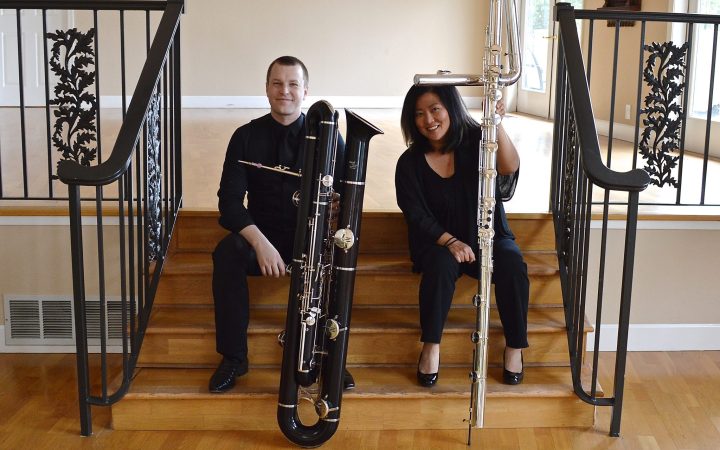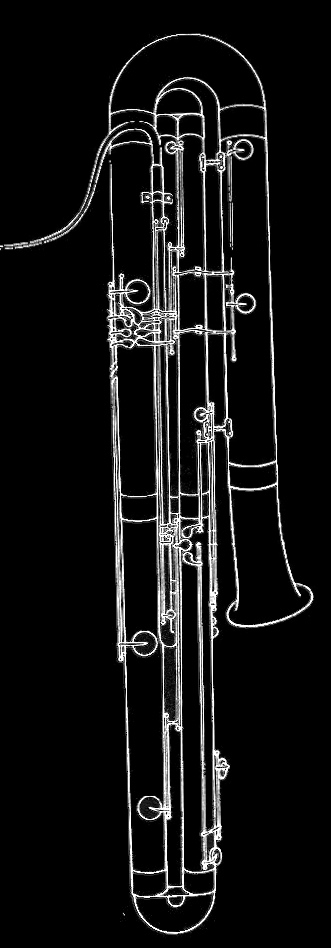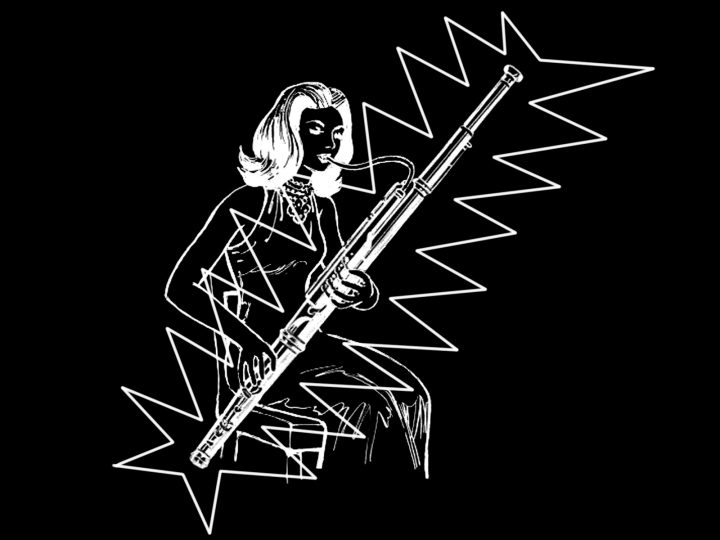
Keyed Kontraptions is having a live streamed concert this tuesday at 2pm Pacific Standard Time. Find the event here KK LIVE

Keyed Kontraptions is having a live streamed concert this tuesday at 2pm Pacific Standard Time. Find the event here KK LIVE




Large woodwind instruments have problems with water and condensation from regular playing. Not to mention the amount of playing that occurs in the lead in to a recital or audition. Contrabassoons are especially susceptible to water damage because they do not come apart to be swabbed, and most players cannot take their contras apart without damaging the seal when putting it back together.
Just last week I was talking to a woman who had bought a Mollenhauer contrabassoon in an estate sale. She bought half of it along with another bassoonist, and they shared it. But after a few months of playing and putting it back into the case one of them developed a cough, and through some sleuthing, found that the contrabassoon was full of mold! They brought it to a repairman who cleaned it out but it was never the same. We all heard about Trombone Lung a few years ago. This stuff can really cause respiratory ailments along the lines of Anthrax.
The best method for keeping a contrabassoon dry is to remove the tuning slide and leave it out on the stand for a few hours after playing. This won’t prevent all problems, on older contras water damage can even be seen on the outside of the instrument, through the lacquer. The contra’s “wing joint” is the common problem, this is the first piece of wood after the first bend. The danger is mold, and that the mold can damage the seal of the instrument and eat away at the wood of the bore, changing the dimensions.
Contraforte has a bad side and a good side. The bad side is that there is no tuning slide, and so nothing can be opened to help it air out; the good side is the modular design which allows players to take apart their own instruments. I can safely loosen the C-clamps and remove a bend to clean out sections. Recently I removed the second bend for the first time to find that it was lined with mold. The first bore can air dry but after a certain point the circulation doesn’t dry out the entire bore. This means that I need to do regular checks and cleanings at least once every two months.
The best tools for preventing life in an instrument are rubbing alcohol and a dehumidifier. Find a small spray bottle capable of an extremely fine mist, as fine as an aerosol spray. fill it with rubbing alcohol and spray it down the bore when you finish playing and right before you swab (non-contra) The alcohol mist will sterilize the bore and the hard to reach tone holes with the added benefit of evaporating quickly. I even do this to my bassoon before I swab it and put it away. Having a dehumidifier drying out the air makes it difficult for mold and fungi to take hold.
Today I did a large scale cleaning by removing all bends and using a fine sprayer of rubbing alcohol. By spraying sections at a time and swabbing them I killed any mold spores and other microbes living inside.
I have recently invested in a great dehumidifier from Lowes which has improved the air quality. I highly recommend a dehumidifier for woodwind players or doublers. If you can imagine all of the moisture that accumulates in the air from playing multiple instruments and reed making, it makes it hard for things to dry out fully. Especially here in the San Francisco Bay Area there is constant fog and moisture from the sea. I have been keeping my instruments at 45% humidity, this has already stopped my problem of sticky pads.
I have been arranging the Bach Partita for bassoon/contrabassoon. Each of the movements can be found as PDF files on the right sidebar for your own use. I have been having fun with the contraforte recently so I did them on the CF.
This last week I had the opportunity to play the film score to “Modern Times” This is one of the final silent films and the last appearance of Charlie Chaplin’s “little scamp” character. Each performance was sold out and the audience was very receptive.
This project was my first time playing a film score along with the film, and it was stressful. The conductor has strict timing to follow and so the musical cues have little prep. He mostly watches the film waiting for certain scene changes and action to start the different orchestra cues. The fun part was playing the bassoon solos which are mostly jokey and loud. there are a few cool english horn solos and some very fast over the top tempos.
I have been putting out reed orders for the past few months with great success and have had a great time connecting with customers. However it has been a hassle to manage reed orders along side regular gig emails etc. so I decided to create a reed website! It is a site that will be constantly updated with new products and cane sources. So feel free to check it out!
There is an icon (will make more sense in a few updates) at the bottom of the webpage linking to my eBay store. That is where I sell sale reeds or inventory that I need to move, usually at a reduced price.
This year was my first IDRS conference yet and it was amazing! I met so many legendary players and nice people. There was an entire room of vendors and instruments to try as well as a room full of music provided by trevco. The bassoon selection was impressive and included:
Püchner
Fox
Moosmann
Walter
Wolf
Schreiber
and oboes were brought by
Marigaux
Buffet
Fox
Püchner
It was odd that even though there were Loree oboes and Heckel bassoon at the conference. Loree and Heckel were not there only their used instruments were sold through other sellers.
Legère reeds were there and many more bassoons were hooked onto some synthetic reeds. Other innovations were brought by Guntram Wolf. They brought a Lupophon and the Contraforte.
Now this is particularly interesting to me because I have been seriously getting into contrabassoon and I feel a strong pull towards the contraforte. I am now raising funds to buy a contraforte to take auditions with. I have a list of repertoire to perform and record on it and was a great treat to get to play another one this week. If you ever get a chence to get your hands on a contraforte, test it! the dynamics, range, note connection is all much easier.
This is a project I premiered with oboist, Sydne Sullivan. Written by Joseph M. Colombo.
This last month I have been playing in a musical. I am playing in a Stephen Sondheim show called “A little night music” it’s being produced with a reduced score.
I have never played a musical before! I’ve been in many operas and symphony shows but never a musical, so I was initially very confused as to how the woodwind part worked. This is so far what I have learned…
Reed 1 is flute, piccolo, alto flute, and maybe clarinet
Reed 2 is flute, clarinet, and maybe alto sax
Reed 3 is clarinet, bass clarinet or tenor sax
Reed 4 can be oboe/english horn
Reed 5 is baritone sax, bassoon, bass clarinet
this is basically what I know about musical scoring so far. I think that the reed parts are different for every show and what I gather is that most people who play in musicals regularly are able to double on many instruments. Basically everyone can play flute and clarinet and sax, but only one person has to have/play the oboe, the bassoon, and the bass clarinet.
A Little night music has me on Reed 5 and for this show this means that it is only a bassoon part, which is rare. What is also specific to musicals is having a long run of a shows. Most projects have a weekends of concerts but musicals can have multiple weeks of shows.
Woodwind players often try new things to “spice up” their playing. Even new instruments emerge with the amount of experimentation, new compositions, technology, and new materials available. Here are a few of my favorite double reed innovations of the last ten years.
German bassoon system add ons:
wing joint system to high G
more about Robert’s bassoon can be found at his website
http://www.robertronnes.com/MyBassoons.html
Guntram Wolf Instruments
Kontraforte (revised contra bassoon)
Lupophon (revised bass oboe)
more information about Wolf instruments and products can be found at:
http://www.guntramwolf.de/englisch/instrumente.html
Loboe (low A oboe)
The new Püchner oboe bell
Marigaux plexiglass oboe
Fox plexiglass bassoon